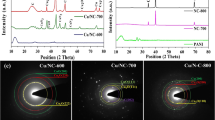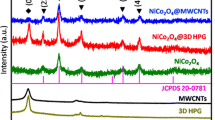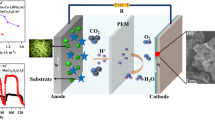Abstract
Despite the wide application of activated carbon (AC) as cathode electrocatalyst in microbial fuel cell (MFC), the enhancement of its catalytic activity is crucial to reduce its high loading on air-cathode. Herein, we synthesize nitrogen-doped activated carbon (NAC) by pyrolyzing phthalocyanine (Pc) adsorbed on AC to develop an efficient oxygen reduction reaction (ORR) electrocatalyst. The optimized mass ratio of AC to Pc improves the crystalline structure and porous structure of the NAC. Elemental analysis indicates that this material contains appropriate content of pyrrolic and pyridinic types of nitrogen and oxygen species. The NAC shows an ORR onset potential of 0.468 V (vs. Standard hydrogen electrode), an electron transfer number of 3.90, and high electrochemically accessible surface area, thereby illustrating enhanced electrocatalytic activity in the neutral medium relative to alkali-treated activated carbon (b-AC) and commercial platinum catalyst. Owing to the high activity, a small amount of NAC with a loading of 15 mg cm− 2 on the air-cathode of MFC is sufficient to achieve the maximum power density of 1026.07 ± 10.83 mW m− 2, which is higher than that of b-AC and comparable to platinum catalyst. The reduced loading of NAC indicates that the material can be used as cathode electrocatalyst for the ongoing effort to scale up MFC in the future.
Graphical abstract








Similar content being viewed by others
Abbreviations
- AC:
-
Activated carbon
- BET:
-
Brunauer–Emmett–Teller
- BJH:
-
Barrett–Joyner–Halenda
- CE:
-
Coulombic efficiency
- COD:
-
Chemical oxygen demand
- CV:
-
Cyclic voltammetry
- ECSA:
-
Electrochemical accessible surface area
- LSV:
-
Linear sweep voltammetry
- MFC:
-
Microbial fuel cell
- MPD:
-
Maximum power density
- NAC:
-
Nitrogen-doped activated carbon
- OCV:
-
Open-circuit voltage
- ORR:
-
Oxygen reduction reaction
- PBS:
-
Phosphate-buffered saline
- Pc:
-
Phthalocyanine
- PGMs:
-
Platinum group metals
- RRDE:
-
Rotating ring-disk electrode
- SEM:
-
Scanning electron microscopy
- SHE:
-
Standard hydrogen electrode
- XPS:
-
X-ray photoelectron spectroscopy
- XRD:
-
X-ray diffraction
- %H2O2 :
-
Yield percentage of H2O2 (%)
- j 0 :
-
Exchange current density (mA cm− 2)
- n :
-
Electron transfer number
- η :
-
Overpotential (mV)
References
Logan BE, Hamelers B, Rozendal RA, Schrorder U, Keller J, Freguia S, Aelterman P, Verstraete W, Rabaey K (2006) Microbial fuel cells: methodology and technology. Environ Sci Technol 40:5181–5192. https://doi.org/10.1021/es0605016
Logan BE, Rabaey K (2012) Conversion of wastes into bioelectricity and chemicals by using microbial electrochemical technologies. Science 337:686–690. https://doi.org/10.1126/science.1217412
Santoro C, Arbizzani C, Erable B, Ieropoulos I (2017) Microbial fuel cells: from fundamentals to applications. A review. J Power Sources 356:225–244. https://doi.org/10.1016/j.jpowsour.2017.03.109
Liew KB, Daud WRW, Ghasemi M, Leong JX, Lim SS, Ismail M (2014) Non-Pt catalyst as oxygen reduction reaction in microbial fuel cells: a review. Int J Hydrogen Energy 39:4870–4883. https://doi.org/10.1016/j.ijhydene.2014.01.062
Yuan HY, He Z (2015) Graphene-modified electrodes for enhancing the performance of microbial fuel cells. Nanoscale 7:7022–7029. https://doi.org/10.1039/c4nr05637j
Wang ZJ, Mahadevan GD, Wu YC, Zhao F (2017) Progress of air-breathing cathode in microbial fuel cells. J Power Sources 356:245–255. https://doi.org/10.1016/j.jpowsour.2017.02.004
Liu Y, Liu H, Wang C, Hou SX, Yang N (2013) Sustainable energy recovery in wastewater treatment by microbial fuel cells: stable power generation with nitrogen-doped graphene cathode. Environ Sci Technol 47:13889–13895. https://doi.org/10.1021/es4032216
Liu Y, Jin XJ, Tuo AX, Liu H (2016) Improved oxygen reduction reaction activity of three-dimensional porous N-doped graphene from a soft-template synthesis strategy in microbial fuel cells. RSC Adv 6:105211–105221. https://doi.org/10.1039/c6ra23971d
You SJ, Gong XB, Wang W, Qi DP, Wang XH, Chen XD, Ren NQ (2016) Enhanced cathodic oxygen reduction and power production of microbial fuel cell based on noble-metal-free electrocatalyst derived from metal-organic frameworks. Adv Energy Mater 6:1501497. https://doi.org/10.1002/aenm.201501497
Sun Y, Duan YQ, Hao L, Xing ZP, Dai Y, Li R, Zou JL (2016) Cornstalk-derived nitrogen-doped partly graphitized carbon as efficient metal-free catalyst for oxygen reduction reaction in microbial fuel cells. ACS Appl Mater Interfaces 8:25923–25932. https://doi.org/10.1021/acsami.6b06895
Zhang F, Cheng SA, Pant D, Van Bogaert G, Logan BE (2009) Power generation using an activated carbon and metal mesh cathode in a microbial fuel cell. Electrochem Commun 11:2177–2179. https://doi.org/10.1016/j.elecom.2009.09.024
Dong H, Yu HB, Wang X (2012) Catalysis kinetics and porous analysis of rolling activated carbon-PTFE air-cathode in microbial fuel cells. Environ Sci Technol 46:13009–13015. https://doi.org/10.1021/es303619a
Li D, Qu YP, Liu J, He WH, Wang HM, Feng YJ (2014) Using ammonium bicarbonate as pore former in activated carbon catalyst layer to enhance performance of air cathode microbial fuel cell. J Power Sources 272:909–914. https://doi.org/10.1016/j.jpowsour.2014.09.053
Ge Z, He Z (2015) An effective dipping method for coating activated carbon catalyst on the cathode electrodes of microbial fuel cells. RSC Adv 5:36933–36937. https://doi.org/10.1039/c5ra05543a
Zhang XY, He WH, Yang WL, Liu J, Wang QY, Liang P, Huang X, Logan BE (2016) Diffusion layer characteristics for increasing the performance of activated carbon air cathodes in microbial fuel cells. Environ Sci Water Res Technol 2:266–273. https://doi.org/10.1039/c5ew00245a
Dong H, Yu HB, Wang X, Zhou QX, Feng JL (2012) A novel structure of scalable air-cathode without Nafion and Pt by rolling activated carbon and PTFE as catalyst layer in microbial fuel cells. Water Res 46:5777–5787. https://doi.org/10.1016/j.watres.2012.08.005
Watson VJ, Delgado CN, Logan BE (2013) Improvement of activated carbons as oxygen reduction catalysts in neutral solutions by ammonia gas treatment and their performance in microbial fuel cells. J Power Sources 242:756–761. https://doi.org/10.1016/j.jpowsour.2013.05.135
Zhang F, Pant D, Logan BE (2011) Long-term performance of activated carbon air cathodes with different diffusion layer porosities in microbial fuel cells. Biosens Bioelectron 30:49–55. https://doi.org/10.1016/j.bios.2011.08.025
Zhang XY, Pant D, Zhang F, Liu J, He WH, Logan BE (2014) Long-term performance of chemically and physically modified activated carbons in air cathodes of microbial fuel cells. ChemElectroChem 1:1859–1866. https://doi.org/10.1002/celc.201402123
Zhang XY, Xia X, Ivanov I, Huang X, Logan BE (2014) Enhanced activated carbon cathode performance for microbial fuel cell by blending carbon black. Environ Sci Technol 48:2075–2081. https://doi.org/10.1021/es405029y
Yang WL, Logan BE (2016) Immobilization of a metal–nitrogen–carbon catalyst on activated carbon with enhanced cathode performance in microbial fuel cells. ChemSusChem 9:2226–2232. https://doi.org/10.1002/cssc.201600573
Zhang XY, Wang QY, Xia X, He WH, Huang X, Logan BE (2017) Addition of conductive particles to improve the performance of activated carbon air-cathodes in microbial fuel cells. Environ Sci Water Res Technol 3:806–810. https://doi.org/10.1039/c7ew00108h
Li N, Liu YN, An JK, Feng CJ, Wang X (2014) Bifunctional quaternary ammonium compounds to inhibit biofilm growth and enhance performance for activated carbon air-cathode in microbial fuel cells. J Power Sources 272:895–899. https://doi.org/10.1016/j.jpowsour.2014.09.008
Pu LT, Li KX, Chen ZH, Zhang P, Zhang X, Fu Z (2014) Silver electrodeposition on the activated carbon air cathode for performance improvement in microbial fuel cells. J Power Sources 268:476–481. https://doi.org/10.1016/j.jpowsour.2014.06.071
Zhang X, Li KX, Yan PY, Liu ZQ, Pu LT (2015) N-type Cu2O doped activated carbon as catalyst for improving power generation of air cathode microbial fuel cells. Bioresour Technol 187:299–304. https://doi.org/10.1016/j.biortech.2015.03.131
Huang QS, Zhou PJ, Yang H, Zhu LL, Wu HY (2017) CoO nanosheets in situ grown on nitrogen-doped activated carbon as an effective cathodic electrocatalyst for oxygen reduction reaction in microbial fuel cells. Electrochim Acta 232:339–347. https://doi.org/10.1016/j.electacta.2017.02.163
Wang X, Gao NSJ, Zhou QX, Dong H, Yu HB, Feng YJ (2013) Acidic and alkaline pretreatments of activated carbon and their effects on the performance of air-cathodes in microbial fuel cells. Bioresour Technol 144:632–636. https://doi.org/10.1016/j.biortech.2013.07.022
Chen ZH, Li KX, Zhang P, Pu LT, Zhang X, Fu Z (2015) The performance of activated carbon treated with H3PO4 at 80 °C in the air-cathode microbial fuel cell. Chem Eng J 259:820–826. https://doi.org/10.1016/j.cej.2014.08.059
Wang Z, Liu Y, Li KX, Liu D, Yang TT, Wang JJ, Lu JF (2017) The influence and mechanism of different acid treatment to activated carbon used as air-breathing cathode catalyst of microbial fuel cell. Electrochim Acta 246:830–840. https://doi.org/10.1016/j.electacta.2017.05.086
Watson VJ, Delgado CN, Logan BE (2013) Influence of chemical and physical properties of activated carbon powders on oxygen reduction and microbial fuel cell performance. Environ Sci Technol 47:6704–6710. https://doi.org/10.1021/es401722j
Zhang B, Wen ZH, Ci SQ, Mao S, Chen JH, He Z (2014) Synthesizing nitrogen-doped activated carbon and probing its active sites for oxygen reduction reaction in microbial fuel cells. ACS Appl Mater Interfaces 6:7464–7470. https://doi.org/10.1021/am5008547
Liu YT, Li KX, Liu Y, Pu LT, Chen ZH, Deng SG (2015) The high-performance and mechanism of P-doped activated carbon as a catalyst for air-cathode microbial fuel cells. J Mater Chem A 3:21149–21158. https://doi.org/10.1039/c5ta04595a
Wang HM, Li D, Liu J, Liu LC, Zhou XT, Qu YP, Zhang J, Feng YJ (2016) Microwave-assisted synthesis of nitrogen-doped activated carbon as an oxygen reduction catalyst in microbial fuel cells. RSC Adv 6:90410–90416. https://doi.org/10.1039/c6ra14387c
Xia X, Zhang F, Zhang XY, Liang P, Huang X, Logan BE (2013) Use of pyrolyzed iron ethylenediaminetetraacetic acid modified activated carbon as air-cathode catalyst in microbial fuel cells. ACS Appl Mater Interfaces 5:7862–7866. https://doi.org/10.1021/am4018225
Pan YJ, Mo XP, Li KX, Pu LT, Liu D, Yang TT (2016) Iron-nitrogen-activated carbon as cathode catalyst to improve the power generation of single-chamber air-cathode microbial fuel cells. Bioresour Technol 206:285–289. https://doi.org/10.1016/j.biortech.2016.01.112
Zitolo A, Goellner V, Armel V, Sougrati MT, Mineva T, Stievano L, Fonda E, Jaouen F (2015) Identification of catalytic sites for oxygen reduction in iron- and nitrogen-doped graphene materials. Nat Mater 14:937–942. https://doi.org/10.1038/NMAT4367
Cao RG, Thapa R, Kim H, Xu XD, Kim MG, Li Q, Park N, Liu ML, Cho J (2013) Promotion of oxygen reduction by a bio-inspired tethered iron phthalocyanine carbon nanotube-based catalyst. Nat Commun 4:2076. https://doi.org/10.1038/ncomms3076
de Oliveira MAC, Mecheri B, D’Epifanio A, Placidi E, Arciprete F, Valentini F, Perandini A, Valentini V, Licoccia S (2017) Graphene oxide nanoplatforms to enhance catalytic performance of iron phthalocyanine for oxygen reduction reaction in bioelectrochemical systems. J Power Sources 356:381–388. https://doi.org/10.1016/j.jpowsour.2017.02.009
Santoro C, Gokhale R, Mecheri B, D’Epifanio A, Licoccia S, Serov A, Artyushkova K, Atanassov P (2017) Design of iron(II) pthalocyanine (FePc) derived oxygen reduction electrocatalysts for high power density microbial fuel cells. ChemSusChem 10:3243–3251. https://doi.org/10.1002/cssc.201700851
Zhang ZP, Dou ML, Ji J, Wang F (2017) Phthalocyanine tethered iron phthalocyanine on graphitized carbon black as superior electrocatalyst for oxygen reduction reaction. Nano Energy 34:338–343. https://doi.org/10.1016/j.nanoen.2017.02.042
Champavert J, Rejeb SB, Innocent C, Pontié M (2015) Microbial fuel cell based on Ni-tetra sulfonated phthalocyanine cathode and graphene modified bioanode. J Electroanal Chem 757:270–276. https://doi.org/10.1016/j.jelechem.2015.09.012
Yang Y, Liu TY, Zhu X, Zhang F, Ye DD, Liao Q, Li Y (2016) Boosting power density of microbial fuel cells with 3d nitrogen-doped graphene aerogel electrode. Adv Sci 3:1600097. https://doi.org/10.1002/advs.201600097
Jarzabek G, Borkowska Z (1997) On the real surface area of smooth solid electrodes. Electrochim Acta 42:2915–2918. https://doi.org/10.1016/S0013-4686(97)00112-6
Konopka SJ, McDuffie B (1970) Diffusion coefficients of ferricyanide and ferrocyanide ions in aqueous media, using twin-electrode thin-layer electrochemistry. Anal Chem 42:741–1746. https://doi.org/10.1021/ac50160a042
Kim JR, Cheng SA, Oh SE, Logan BE (2007) Power generation using different cation, anion, and ultrafiltration membranes in microbial fuel cells. Environ Sci Technol 41:1004–1009. https://doi.org/10.1021/es062202m
Zhang F, Saito T, Cheng SA, Hickner MA, Logan BE (2010) Microbial fuel cell cathodes with poly(dimethylsiloxane) diffusion layers constructed around stainless steel mesh current collectors. Environ Sci Technol 44:1490–1495. https://doi.org/10.1021/es903009d
Lovley DR, Phillips EJP (1988) Novel mode of microbial energy metabolism: organic carbon oxidation coupled to dissimilatory reduction of iron or manganese. Appl Environ Microbiol 54:1472–1480
Zhou XJ, Bai ZY, Wu MJ, Qiao JL, Chen ZW (2015) 3-Dimensional porous N-doped graphene foam as a non-precious catalyst for the oxygen reduction reaction. J Mater Chem A 3:3343–3350. https://doi.org/10.1039/c4ta06538g
Lv K, Zhang H, Chen SL (2018) Nitrogen and phosphorus co-doped carbon modified activated carbon as an efficient oxygen reduction catalyst for microbial fuel cells. RSC Adv 8:848–855. https://doi.org/10.1039/c7ra12907f
Jaouen F, Proietti E, Lefèvre M, Chenitz R, Dodelet JP, Wu G, Chung HT, Johnston CM, Zelenay P (2011) Recent advances in non-precious metal catalysis for oxygen-reduction reaction in polymer electrolyte fuel cells. Energy Environ Sci 4:114–130. https://doi.org/10.1039/c0ee00011f
Videla AHAM, Zhang L, Kim J, Zeng J, Francia C, Zhang J, Specchia S (2013) Mesoporous carbons supported non-noble metal Fe-N(X) electrocatalysts for PEM fuel cell oxygen reduction reaction. J Appl Electrochem 43:159–169. https://doi.org/10.1007/s10800-012-0497-y
Yang TT, Li KX, Pu LT, Liu ZQ, Ge BC, Pan YJ, Liu Y (2016) Hollow-spherical Co/N-C nanoparticle as an efficient electrocatalyst used in air cathode microbial fuel cell. Biosens Bioelectron 86:129–134. https://doi.org/10.1016/j.bios.2016.06.032
Lai LF, Potts JR, Zhan D, Wang L, Poh CK, Tang CH, Gong H, Shen ZX, Lin JY, Ruoff RS (2012) Exploration of the active center structure of nitrogen-doped graphene-based catalysts for oxygen reduction reaction. Energy Environ Sci 5:7936–7942. https://doi.org/10.1039/c2ee21802j
Zhang H, Yang JT, Hou HQ, Chen SL, Yao HM (2017) Nitrogen-doped carbon paper with 3d porous structure as a flexible free-standing anode for lithium-ion batteries. Sci Rep 7:7769. https://doi.org/10.1038/s41598-017-07345-y
Yu DS, Zhang Q, Dai LM (2010) Highly efficient metal-free growth of nitrogen-doped single-walled carbon nanotubes on plasma-etched substrates for oxygen reduction. J Am Chem Soc 132:15127–15129. https://doi.org/10.1021/ja105617z
Wang QY, Zhang XY, Lv RT, Chen X, Xue BR, Liang P, Huang X (2016) Binder-free nitrogen-doped graphene catalyst air-cathodes for microbial fuel cells. J Mater Chem A 4:12387–12391. https://doi.org/10.1039/C6TA03642B
Gong XB, You SJ, Wang XH, Zhang JN, Gan Y, Cui CW, Ren NQ (2014) Improved interfacial oxygen reduction by ethylenediamine tetraacetic acid in the cathode of microbial fuel cell. Biosens Bioelectron 58:272–275. https://doi.org/10.1016/j.bios.2014.02.073
Guo DH, Shibuya R, Akiba C, Saji S, Kondo T, Nakamura J (2016) Active sites of nitrogen-doped carbon materials for oxygen reduction reaction clarified using model catalysts. Science 351:361–365. https://doi.org/10.1126/science.aad0832
Zhou JH, Sui ZJ, Zhu J, Li P, Chen D, Dai YC, Yuan WK (2007) Characterization of surface oxygen complexes on carbon nanofibers by TPD, XPS and FT-IR. Carbon 45:785–796. https://doi.org/10.1016/j.carbon.2006.11.019
Liu Y, Jin XJ, Dionysiou DD, Liu H, Huang YM (2015) Homogeneous deposition-assisted synthesis of iron-nitrogen composites on graphene as highly efficient non-precious metal electrocatalysts for microbial fuel cell power generation. J Power Sources 278:773–781. https://doi.org/10.1016/j.jpowsour.2014.12.134
Du J, Mishra D, Ting JM (2013) Surface modified carbon cloth for use in electrochemical capacitor. Appl Surf Sci 285:483–489. https://doi.org/10.1016/j.apsusc.2013.08.081
Jung MJ, Jeong E, Lim JW, Lee SI, Lee YS (2011) Physico-chemical surface modification of activated carbon by oxyfluorination and its electrochemical characterization. Colloid Surf A 389:274–280. https://doi.org/10.1016/j.colsurfa.2011.08.013
Gong KP, Du F, Xia ZH, Durstock M, Dai LM (2009) Nitrogen-doped carbon nanotube arrays with high electrocatalytic activity for oxygen reduction. Science 323:760–764. https://doi.org/10.1126/science.1168049
Zhao X, Chu BT, Ballesteros B, Wang W, Johnston C, Sykes JM, Grant PS (2009) Spray deposition of steam treated and functionalized single-walled and multi-walled carbon nanotube films for supercapacitors. Nanotechnology 20:065605. https://doi.org/10.1088/0957-4484/20/6/065605
Pandolfo AG, Hollenkamp AF (2006) Carbon properties and their role in supercapacitors. J Power Sources 157:11–27. https://doi.org/10.1016/j.jpowsour.2006.02.065
Fu SF, Zhu CZ, Zhou YZ, Yang GH, Jeon JW, Lemmon J, Du D, Nune SK, Lin YH (2015) Metal-organic framework derived hierarchically porous nitrogen-doped carbon nanostructures as novel electrocatalyst for oxygen reduction reaction. Electrochim Acta 178:287–293. https://doi.org/10.1016/j.electacta.2015.08.021
Zhong RS, Qin YH, Niu DF, Tian JW, Zhang XS, Zhou XG, Sun SG, Yuan WK (2013) Effect of carbon nanofiber surface functional groups on oxygen reduction in alkaline solution. J Power Sources 225:192–199. https://doi.org/10.1016/j.jpowsour.2012.10.043
Li J, Song YJ, Zhang GX, Liu HY, Wang YR, Sun SH, Guo XW (2017) Pyrolysis of self-assembled iron porphyrin on carbon black as core/shell structured electrocatalysts for highly efficient oxygen reduction in both alkaline and acidic medium. Adv Funct Mater 27:1604356. https://doi.org/10.1002/adfm.201604356
Jaouen F, Dodelet JP (2009) O2 reduction mechanism on non-noble metal catalysts for PEM fuel cells. Part I: experimental rates of O2 electroreduction, H2O2 electroreduction, and H2O2 disproportionation. J Phys Chem C 113:15422–15432. https://doi.org/10.1021/jp900837e
Jaouen F (2009) O2 reduction mechanism on non-noble metal catalysts for PEM fuel cells. Part II: a porous-electrode model to predict the quantity of H2O2 detected by rotating ring-disk electrode. J Phys Chem C 113:15433–15443. https://doi.org/10.1021/jp900838x
Acknowledgements
This work was supported by the Natural Science Foundation of China (No. 51578526), the Chongqing Research Program of Basic Research and Frontier Technology (No. cstc2015jcyjBX0063), and by Natural Science Foundation of Chongqing (No. cstc2018jcyjAX0327), and the Youth Innovation Promotion Association of Chinese Academy of Sciences (No. 2016341).
Author information
Authors and Affiliations
Corresponding author
Electronic supplementary material
Below is the link to the electronic supplementary material.
Rights and permissions
About this article
Cite this article
Liu, Y., Liu, ZM. Promoted activity of nitrogen-doped activated carbon as a highly efficient oxygen reduction catalyst in microbial fuel cells. J Appl Electrochem 49, 119–133 (2019). https://doi.org/10.1007/s10800-018-1263-6
Received:
Accepted:
Published:
Issue Date:
DOI: https://doi.org/10.1007/s10800-018-1263-6




